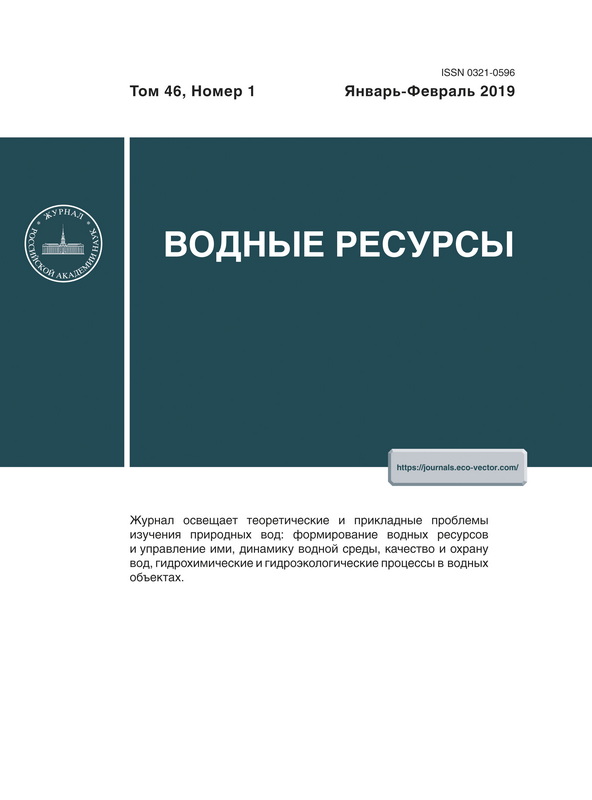Hydrological processes in a lagoon-channel estuary during the warm period of the year: a study of the Bolshaya river mouth, West Kamchatka
- 作者: Gorin S.L.1, Popryadukhin A.A.2, Koval' M.V.3
-
隶属关系:
- Russian Research Institute of Fisheries and Oceanography
- Moscow State University
- Kamchatka Research Institute of Fisheries and Oceanography
- 期: 卷 46, 编号 1 (2019)
- 页面: 2-13
- 栏目: Водные ресурсы и режим водных объектов
- URL: https://journals.eco-vector.com/0321-0596/article/view/10906
- DOI: https://doi.org/10.31857/S0321-05964612-13
- ID: 10906
如何引用文章
详细
Based on long-term field studies, we investigated the hydrological regime of the lagoon-channel estuary of the Bolshaya river. This river is located in the Kamchatka Krai, which is one of the most remote and underdeveloped regions of Russia. Numerous observations were made of the estuary and its processes, and the natural environment in which it exists.
全文:
作者简介
S. Gorin
Russian Research Institute of Fisheries and Oceanography
编辑信件的主要联系方式.
Email: gorinser@mail.ru
俄罗斯联邦, 17, V. Krasnoselskaya, Moscow, 107140
A. Popryadukhin
Moscow State University
Email: gorinser@mail.ru
Faculty of Geography
俄罗斯联邦, 1, Leninskie gory, Moscow, 119991M. Koval'
Kamchatka Research Institute of Fisheries and Oceanography
Email: gorinser@mail.ru
俄罗斯联邦, 18, Naberejnaya str., Petropavlovsk-Kamchatskii, 683000
参考
- Гидрологические наблюдения и работы на гидрометеорологической сети в устьевых областях рек. Методические указания. М.: Гидрометеоиздат, 1993. 183 с.
- Гидрометеорология и гидрохимия морей. Т. IX. Охотское море. Вып. 1. Гидрометеорологические условия. СПб.: Гидрометеоиздат, 1998. 342 с.
- Горин С.Л. Изменение гидрологических условий в эстуарии реки Большой в процессе его развития // Сохранение биоразнообразия Камчатки и прилегающих морей. Материалы VII междунар. научн. конф. Петропавловск-Камчатский, 2006. С. 66–69.
- Горин С.Л. История отображения эстуария реки Большой (Западная Камчатка) на картах // Сохранение биоразнообразия Камчатки и прилегающих морей. Материалы IX междунар. научн. конф. Петропавловск-Камчатский, 2008. С. 60–64.
- Горин С.Л. Гидролого-морфологические исследования эстуария р. Большой и Октябрьской косы в XVIII–XX вв. // Материалы междунар. исторических XXVI Крашенинниковских чтений. Петропавловск-Камчатский, 2009. С. 73–76.
- Горин С.Л. Эстуарии полуострова Камчатка: теоретические подходы к изучению и гидролого-морфологическая типизация. Итоги 10 лет исследований // Исследования водных биологических ресурсов Камчатки и Северо-Западной части Тихого океана. 2012. Вып. 27. С. 5–12.
- Горин С.Л. Современные морфологическое строение и гидрологический режим эстуария реки Камчатки // Исследования водных биологических ресурсов Камчатки и Северо-Западной части Тихого океана. 2013. Вып. 31. С. 6–26.
- Горин С.Л. Морфодинамика устья реки Камчатка в XVIII–XX вв. и ее влияние на гидрологический режим устьевых водоемов // Исследования водных биологических ресурсов Камчатки и Северо-Западной части Тихого океана. 2014. Вып. 32. С. 79–88.
- Горин С.Л., Игнатов Е.И., Кравчуновская Е.А., Корзинин Д.В., Тембрел И.И. Морфодинамика Октябрьской косы (Охотоморское побережье Камчатки) // Морские берега – эволюция, экология, экономика. Материалы XXIV междунар. береговой конф. Краснодар, 2012. Т. 1. С. 94–97.
- Горин С.Л., Коваль М.В. Состояние и перспективы исследований в эстуариях Камчатского края // Фундаментальные проблемы воды и водных ресурсов. Тр. Четвертой Всерос. научн. конф. с международ. участием. 2015. С. 402–405.
- Кравчуновская Е.А., Тембрел И.И., Горин С.Л. Штормовые переливы на Октябрьской косе и их воздействие на автодорогу Усть-Большерецк – Октябрьский // Морские берега – эволюция, экология, экономика. Материалы XXIV Международ. береговой конф. Краснодар, 2012. Т. 1. С. 211–214.
- Михайлов В.Н. Устья рек России и сопредельных стран: прошлое, настоящее и будущее. М.: ГЕОС, 1997. 413 с.
- Михайлов В.Н. Гидрологические процессы в устьях рек. М.: ГЕОС, 1997. 175 с.
- Михайлов В.Н., Горин С.Л. Новые определения, районирование и типизация устьевых областей рек и их частей — эстуариев // Вод. ресурсы. 2012. Т. 39. № 3. С. 243–257.
- Разработка рекомендаций по защите косы от разрушения волнами у Октябрьского рыбокомбината (архив Камчатского УГМС). Владивосток: Дальморниипроект, 1982. 95 с.
- Функционирование субарктической гидротермальной экосистемы в зимний период / Под ред. Болотова И.Н. Екатеринбург: УрО РАН, 2011. 252 с.
- Чугаев Р.Р. Гидравлика. Л.: Энергия, 1975. 600 с.
补充文件








